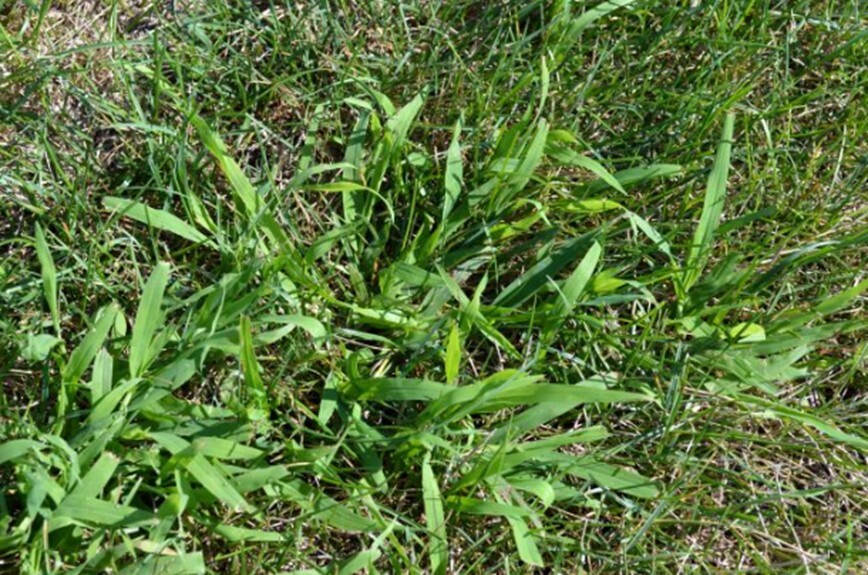Key Takeaways
- Early identification of crabgrass is crucial for effective control.
- Pre-emergent herbicides are most effective when applied in early spring, before crabgrass seeds begin to germinate.
- Maintaining a healthy lawn through proper mowing, watering, and fertilization deters crabgrass growth.
- Post-emergent treatments can address existing infestations.
- Professional lawn care services offer tailored solutions for persistent crabgrass problems.
What Is Crabgrass?
Crabgrass (Digitaria spp.) is an annual warm-season grass that thrives in hot, dry conditions. It germinates in the spring when soil temperatures reach about 55–60°F (12–15°C), typically around the time when forsythia shrubs bloom. Unlike desirable turfgrass, crabgrass grows rapidly and spreads horizontally, forming dense mats that can crowd out your lawn.
Identifying Crabgrass
Crabgrass is easy to spot once established. It has wide, coarse leaves and stems that radiate outward, resembling crab legs.
Identification
- Appearance: Light green, coarse-textured grass with wide blades.
- Growth Pattern: Low-growing with stems that radiate outward, resembling crab legs.
- Seed Heads: Finger-like projections that emerge as the plant matures.
Why Crabgrass Is a Problem
Crabgrass competes with your lawn for water, nutrients, and sunlight. It thrives in conditions where turfgrass is weak or sparse, such as compacted soil, poor irrigation, or improper mowing. Once established, crabgrass can quickly dominate bare spots and thin turf, leading to an unsightly lawn and increased maintenance costs.
Preventing Crabgrass
Prevention is the most effective strategy for managing crabgrass. Here’s how to keep it at bay:
1. Apply Pre-Emergent Herbicides
Pre-emergent herbicides form a protective barrier in the soil that stops crabgrass seeds from sprouting before they can take hold. Timing is crucial: apply the weed control herbicide in early spring, when soil temperatures reach 50–55°F (10–13°C) at a depth of 1–2 inches, or when forsythia blooms begin to drop. Common pre-emergent herbicides include:
- Benefin (e.g., Balan)
- Dithiopyr (e.g., Dimension)
- Pendimethalin (e.g., Scott’s Halts)
- Prodiamine (e.g., Barricade)
These products are most effective when applied before crabgrass seeds germinate and should not be used if you plan to overseed your lawn, as they can also prevent desirable grass seed from sprouting.
2. Maintain a Healthy Lawn
A thick, healthy lawn is your best defense against crabgrass. To promote turf health:
- Mow at the Right Height: Keep your grass at a height of 2.5–3 inches to shade the soil and reduce crabgrass germination.
- Water Deeply and Infrequently: Water your lawn deeply once a week to encourage deep root growth. Shallow, frequent watering promotes shallow roots and weakens turfgrass.
- Fertilize Appropriately: Apply fertilizer substance in the spring and fall to support healthy growth. Avoid fertilizing during the summer heat, as this can stress your lawn and favor crabgrass.
3. Repair Bare Spots Promptly
Bare spots in your lawn provide ideal conditions for crabgrass to establish. Reseed these areas promptly to maintain a dense turf canopy that can outcompete weeds.
Managing Established Crabgrass
If crabgrass has already taken hold in your lawn, early intervention is key:
- Manual Removal: For minor outbreaks, hand-pulling is a practical approach. Be sure to extract the entire root system to reduce the chance of regrowth.
- Post-Emergent Herbicides: For larger infestations, post-emergent herbicides containing active ingredients can be used. These are most effective on young, actively growing crabgrass.
- Overseeding: After removing crabgrass, overseed the area to fill in bare spots and prevent future weed establishment.
Seasonal Considerations
Crabgrass management varies with the seasons:
- Spring: Apply pre-emergent herbicides early in the season to block crabgrass seeds from sprouting and establishing in your lawn.
- Summer: Maintain lawn health through proper watering and mowing in summer. Avoid fertilizing during peak heat.
- Fall: Reseed bare spots and consider applying a fall fertilizer to strengthen turfgrass for the winter.
- Winter: Avoid heavy foot traffic on frozen turf to prevent soil compaction and damage.
Professional Assistance
Persistent crabgrass problems may require professional intervention. Lush Lawn offers comprehensive lawn care services tailored to your yard's specific needs. Our experts can assess your lawn, recommend appropriate treatments, and implement a plan to restore its health.
Our services include:
- Lawn Care Services & Weed Control: Comprehensive lawn treatments tailored to your turf’s needs, targeting weeds while promoting thick, green, and resilient grass throughout the seasons.
- Natural Lawn Care: Eco-friendly solutions that improve soil health and grass strength without synthetic chemicals, ideal for families, pets, and environmentally conscious homeowners.
- Grub Control: Protect your lawn from root-damaging grubs with targeted treatments that stop infestations before they destroy turf health and appearance.
- Mole Control for Lawns: Effective solutions to manage mole activity, preventing unsightly tunnels and turf disruption caused by these burrowing pests.
- Vole Control for Lawns: Professional vole control services that address surface damage and nesting, preserving your lawn’s integrity and root systems year-round.
Conclusion
Crabgrass can be a formidable adversary, but with proactive measures and consistent lawn care practices, you can keep it at bay. Should you need assistance, Lush Lawn is here to help you achieve and maintain a healthy, crabgrass-free lawn. Contact us today to schedule a consultation and take the first step toward a more vibrant yard.
FAQs:
What is the ideal time to apply pre-emergent herbicides for crabgrass control?
In early spring, once soil temperatures consistently reach around 55°F for several days.
Can I use natural methods to control crabgrass?
Yes, maintaining a healthy lawn through proper mowing, watering, and fertilization can naturally deter crabgrass.
How does crabgrass spread?
Crabgrass spreads by releasing seeds that typically germinate in late spring through early summer.
Is it necessary to remove dead crabgrass plants?
Yes, removing dead plants prevents them from reseeding and reduces the chance of future infestations.
Can professional lawn care services help with crabgrass control?
Absolutely. Professionals can provide tailored treatments and maintenance plans to effectively manage crabgrass.
